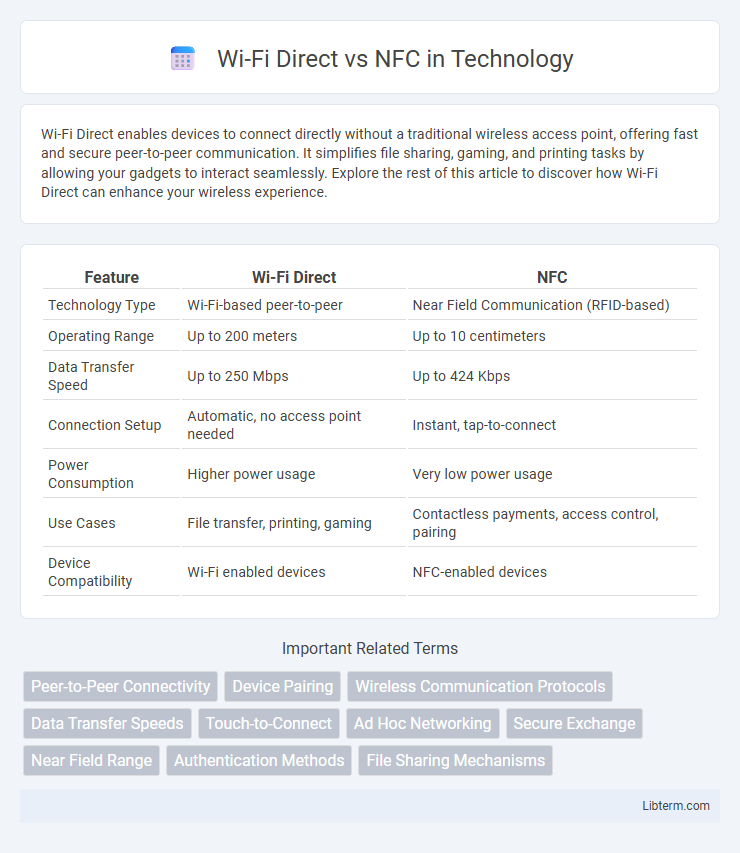Wi-Fi Direct enables devices to connect directly without a traditional wireless access point, offering fast and secure peer-to-peer communication. It simplifies file sharing, gaming, and printing tasks by allowing your gadgets to interact seamlessly. Explore the rest of this article to discover how Wi-Fi Direct can enhance your wireless experience.
Table of Comparison
| Feature | Wi-Fi Direct | NFC |
|---|---|---|
| Technology Type | Wi-Fi-based peer-to-peer | Near Field Communication (RFID-based) |
| Operating Range | Up to 200 meters | Up to 10 centimeters |
| Data Transfer Speed | Up to 250 Mbps | Up to 424 Kbps |
| Connection Setup | Automatic, no access point needed | Instant, tap-to-connect |
| Power Consumption | Higher power usage | Very low power usage |
| Use Cases | File transfer, printing, gaming | Contactless payments, access control, pairing |
| Device Compatibility | Wi-Fi enabled devices | NFC-enabled devices |
Introduction to Wi-Fi Direct and NFC
Wi-Fi Direct enables devices to connect directly over Wi-Fi without requiring a wireless access point, offering high-speed data transfer suitable for activities like file sharing and streaming. Near Field Communication (NFC) facilitates short-range wireless communication typically within a few centimeters, primarily used for quick data exchange, contactless payments, and pairing devices. While Wi-Fi Direct excels in speed and range, NFC provides simplicity and instant connectivity for close-proximity interactions.
How Wi-Fi Direct Works
Wi-Fi Direct enables devices to connect directly via Wi-Fi without needing a wireless access point, creating a peer-to-peer network. It uses Wi-Fi Protected Setup (WPS) for simplified device pairing and supports higher data transfer speeds compared to NFC. This technology allows seamless sharing of large files, streaming, and multiplayer gaming across compatible smartphones, tablets, and laptops.
How NFC Technology Functions
NFC technology functions through close-range wireless communication, enabling devices to exchange data by simply touching or being near each other, typically within 4 centimeters. It uses electromagnetic induction to establish a secure radio connection between two NFC-enabled devices, facilitating quick data transfers or initiating more complex wireless connections like Wi-Fi Direct. Unlike Wi-Fi Direct, which allows longer-range communication and higher data speeds, NFC excels in effortless, secure pairing and initiating interactions without manual setup.
Key Differences Between Wi-Fi Direct and NFC
Wi-Fi Direct offers higher data transfer speeds up to 250 Mbps and supports peer-to-peer connections over longer distances, typically up to 200 meters, whereas NFC operates within a strict range of about 4 cm with speeds around 424 Kbps. Wi-Fi Direct is ideal for activities like large file sharing and media streaming between devices without a wireless router, while NFC excels in quick, secure tap-to-connect interactions such as mobile payments and device pairing. Power consumption is higher in Wi-Fi Direct due to continual radio usage, compared to the ultra-low energy requirements of NFC designed for brief, close-proximity communication.
Speed and Data Transfer Capabilities
Wi-Fi Direct offers significantly higher data transfer speeds, reaching up to 250 Mbps, compared to NFC's maximum of 424 Kbps, enabling faster file sharing and streaming. Wi-Fi Direct supports larger data transfers and more bandwidth-intensive applications, while NFC is primarily used for quick, low-volume transactions like contactless payments or device pairing. The enhanced speed and range of Wi-Fi Direct make it ideal for transferring multimedia content, whereas NFC excels in ease of use for initiating connections.
Range and Connectivity Comparison
Wi-Fi Direct offers a range of up to 200 meters, enabling robust peer-to-peer connections without an access point, suitable for file sharing and device networking over larger distances. NFC operates within a very short range of approximately 4 centimeters, optimized for quick, secure, and effortless pairing or data exchange via touch or proximity. The extended range and higher data transfer speeds of Wi-Fi Direct make it ideal for multimedia sharing, while NFC's limited range provides enhanced security and simplicity for contactless payments and immediate device pairing.
Security Features: Wi-Fi Direct vs NFC
Wi-Fi Direct offers robust security through WPA2 encryption, ensuring secure peer-to-peer connections without requiring a traditional network. NFC provides inherently secure communication by using close-range radio waves, minimizing the risk of eavesdropping or unauthorized access. Both technologies support secure data transfer, but Wi-Fi Direct is better suited for larger file sharing due to its stronger encryption protocols and longer range.
Use Cases and Practical Applications
Wi-Fi Direct enables high-speed file transfers, multiplayer gaming, and printer sharing without needing a wireless router, making it ideal for large media files and collaborative work environments. NFC excels in secure, short-range interactions such as contactless payments, access control, and quick device pairing, due to its low power consumption and instant connectivity. Combining Wi-Fi Direct's bandwidth with NFC's quick initiation enhances smart device ecosystems, from IoT devices to mobile transactions.
Device Compatibility and Support
Wi-Fi Direct supports a wide range of devices, including smartphones, tablets, laptops, and smart TVs, making it highly compatible across various platforms and operating systems like Android, Windows, and some versions of iOS. NFC compatibility is more limited, primarily found in smartphones, contactless payment systems, and a few IoT devices, with most modern Android and some iPhone models supporting it. While Wi-Fi Direct offers broader device interoperability for high-speed data transfer, NFC excels in quick, low-energy device pairing and secure communication with a smaller compatible device ecosystem.
Choosing the Best Technology: Wi-Fi Direct or NFC
Choosing the best technology between Wi-Fi Direct and NFC depends on the specific use case and required data transfer speed. Wi-Fi Direct supports higher data rates up to 250 Mbps ideal for large file transfers and streaming, while NFC offers ultra-short range communication with speeds up to 424 Kbps, perfect for quick device pairing and secure transactions. For applications needing fast, high-volume data exchange, Wi-Fi Direct is optimal; NFC excels in scenarios demanding simplicity, security, and instant connectivity within centimeters.
Wi-Fi Direct Infographic

 libterm.com
libterm.com